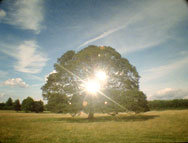Adrian Paci
dal 12/3/2008 al 17/5/2008
Segnalato da
12/3/2008
Adrian Paci
Bonniers Konsthall, Stockholm
Per Speculum. The work takes the viewer to an ostensibly pastoral landscape, where some children play with mirrors, slingshots and reflections of the sun. Having been captured by their own mirror image and the focus of the camera, the children turn the perspective around and fix their gaze on the viewer.

On March 13 Adrian Paci’s film work Per Speculum will receive its Swedish premiere at Bonniers Konsthall. The Albanian-Italian artist’s latest film takes the viewer to an ostensibly pastoral landscape, where some children play with mirrors, slingshots and reflections of the sun. The movie was shot in the summer of 2006 in Milton Keynes in England and is screened with a 35mm projector.
Adrian Paci’s latest film Per Speculum takes place in an idyllic landscape, more reminiscent of a fairy tale than reality. The camera pans over the billowing landscape, but soon focuses on a group of children dressed in timeless clothes. The image zooms out and it is revealed that this image of the children is enclosed within the frame of a large mirror. There they are caught in the eye of the camera and in the reflection from the mirror. A boy picks up a slingshot and releases a shot that shatters the glass of the mirror and the picture it has created. The landscape expands behind the mirror and shows that the children, like a picture in the picture, are captured in a representation of reality.
A simple way of translating Per Speculum is ”by means of a mirror”. The allegorical film contains references to religion, art history and feature films. Towards the end of Per Speculum we see the children perching on branches high up in a tree. They are holding the shards of the mirror glass in their hands towards the camera and blind us with the reflections of the sun. The tree is an ancient Biblical symbol that has been used in art ever since the Middle Ages. The title of the film alludes to the Bible’s First Letter to the Corinthians. Just like the Italian filmmaker Pier Paolo Pasolini, Adrian Paci has also become interested in sacred symbols that are seen, for example, in icon paintings. The children in Per Speculum are extremely similar to the artist’s earlier sketches of film stills from Pasolini’s films Decameron (1971) and The Gospel According to St. Matthew (1964), films that are actually tales from the Bible.
Adrian Paci was born in Shkoder, Albania, in 1969 and is based in Milan. Originally a painter, Paci also works in film, photography, sculpture and installation. The artist has attracted a good deal of attention for his story-telling art, which has often emanated from personal experiences of exile and rootlessness. Adrian Paci is moving forwards with Per Speculum from the documentary element that was characteristic of his many earlier films.
Adrian Paci has exhibited in solo shows and group exhibitions around the world. Previously he has exhibited at Brussels Art Biennial 2007 and Moderna Museet in 2005, amongst other places. In spring 2008 works by Adrian Paci can also be seen at Kunstverein Hanover and Tate Modern in London.
For further information, please contact:
Metta Flensburg, Press Officer Bonniers Konsthall +46-8-736 42 66, +46-70-280 04 13 metta.flensburg@bonnierskonsthall.se
Bonniers Konsthall
Torsgatan 19 - Stockholm



